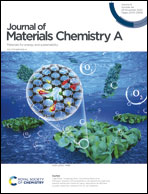Thin laminar composite solid electrolyte with high ionic conductivity and mechanical strength towards advanced all-solid-state lithium–sulfur battery†
Abstract
The development of thin solid-state electrolyte with high ionic conductivity and mechanical strength is of great importance for the high-performance all-solid-state lithium–sulfur battery. However, the state-of-the-art solid polymer electrolyte suffers from poor ionic conductivity and a high thickness but inferior mechanical strength. Herein, a thin laminar composite solid electrolyte (LCSE), namely Vr/PEO-LCSE, is fabricated by filtrating vermiculite nanosheets, followed by intercalation of PEO–LiTFSI into the interlayer through a swelling and filtration method. The continuous interlayer channels with improved PEO chain motility and LiTFSI dissociation afford Vr/PEO-LCSE a highly enhanced ionic conductivity of 1.22 × 10−5 S cm−1 at 25 °C. Together with the low thickness (10 μm), Vr/PEO-LCSE achieves an ultralow area-specific resistance of 66 Ω cm2 at 30 °C, about 50 times lower than pure PEO. Meanwhile, the typical brick-and-mortar architecture combined with the strong rigidity of vermiculite nanosheet imparts Vr/PEO-LCSE an excellent compressive strength of 131 MPa, 550% higher than that of pure PEO. As a result, the rate performance of the assembled Li–S battery is significantly improved. The Li|Vr/PEO-LCSE|S cell achieves low capacity fading as current density increases from 0.05C to 0.20C, and the discharge capacity recovers to 1100 mA h g−1 when the current density switches back to 0.05C.



 Please wait while we load your content...
Please wait while we load your content...